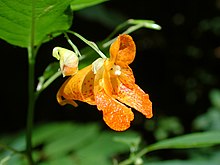
Back Asterids AF نجمانية Arabic Astérides AST Asterids AZ Asterids BCL Астэрыды BE-X-OLD Астериди Bulgarian Asteride BS Astèrides Catalan Asterid CY
| Asterids Temporal range: [1]
| |
|---|---|

| |
| Impatiens capensis (Ericales) | |

| |
| Oregano from Lamiales | |
| Scientific classification | |
| Kingdom: | Plantae |
| Clade: | Tracheophytes |
| Clade: | Angiosperms |
| Clade: | Eudicots |
| Clade: | Core eudicots |
| Clade: | Superasterids |
| Clade: | Asterids |
| Clades | |
In the APG IV system (2016) for the classification of flowering plants, the name asterids denotes a clade (a monophyletic group). Asterids is the largest group of flowering plants, with more than 80,000 species, about a third of the total flowering plant species.[2][3] Well-known plants in this clade include the common daisy, forget-me-nots, nightshades (including potatoes, eggplants, tomatoes, chili peppers and tobacco), the common sunflower, petunias, yacon, morning glory, lettuce, sweet potato, coffee, lavender, lilac, olive, jasmine, honeysuckle, ash tree, teak, snapdragon, sesame, psyllium, garden sage, table herbs such as mint, basil, and rosemary, and rainforest trees such as Brazil nut.
Most of the taxa belonging to this clade had been referred to as Asteridae in the Cronquist system (1981) and as Sympetalae in earlier systems.[citation needed] The name asterids (not necessarily capitalised) resembles the earlier botanical name but is intended to be the name of a clade rather than a formal ranked name, in the sense of the ICBN.
- ^ Atkinson, Brian A. (14 November 2022). "Icacinaceae fossil provides evidence for a Cretaceous origin of the lamiids". Nature Plants. 8 (12): 1374–1377. doi:10.1038/s41477-022-01275-y. ISSN 2055-0278. PMID 36376504. S2CID 253521093.
- ^ Bremer, Kåre; Friis, elsemarie; Bremer, birgitta (1 June 2004). "Molecular Phylogenetic Dating of Asterid Flowering Plants Shows Early Cretaceous Diversification". Systematic Biology. 53 (3): 496–505. doi:10.1080/10635150490445913. PMID 15503676. S2CID 41752744.
- ^ Cite error: The named reference
apgivwas invoked but never defined (see the help page).